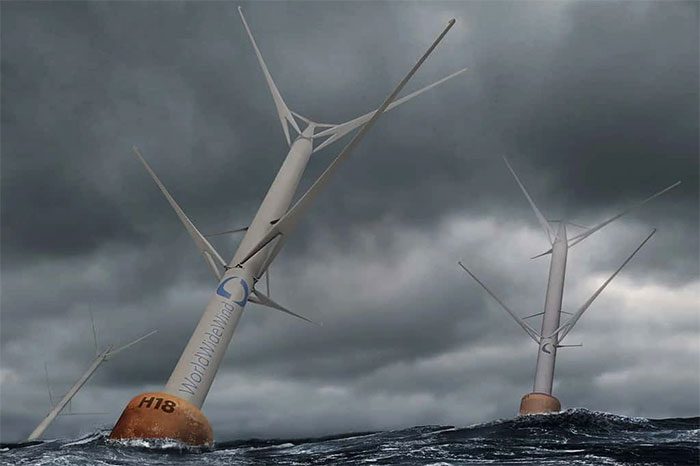A Norwegian company is preparing to test a new type of offshore wind turbine that floats on the surface of the sea and is mounted on a vertical axis rotating in opposite directions.
According to the manufacturer, this technology enables the creation of large-capacity wind turbines at lower costs while minimizing adverse impacts on the surrounding environment.
The world is facing severe consequences from climate change. Many countries, including Vietnam, are in the process of energy transition, reducing greenhouse gas emissions towards the goal of net-zero emissions.

Offshore floating wind turbine rotating in opposite directions ready for testing. (Photo: Futura Science).
In this context, transitioning to renewable energy has become one of the top priorities for countries, with an increasing number of new technologies being developed.
Recently, the Norwegian company World Wide Wind (WWW) announced it has begun testing the first prototype of a counter-rotating floating wind turbine with a capacity of up to 40 megawatts, double that of the largest wind turbine currently available.
Unlike conventional wind turbines that use blades rotating around a horizontal axis, WWW employs a vertical axis wind turbine (VAWT).
The design is quite unusual, utilizing two turbines, each with three blades rotating in opposite directions. The upper turbine is connected to the rotor, while the lower turbine is also connected to the rotor. This new technology allows for double the capacity compared to current wind turbine types at the same rotation speed.
Commercialization by 2030
The turbine blades are set at a 45-degree angle to the vertical axis, which helps reduce the tip speed while allowing the turbines to be installed closer together.
They will also reduce environmental impacts, particularly on the local wildlife. The generator is placed underwater, functioning like a counterweight system that prevents the turbine from lying flat or capsizing under the influence of wind.
This simple design will lower production costs, and the company hopes to achieve a Levelized Cost of Energy (LCOE) of $50 per megawatt-hour (MWh), calculated as the total lifetime cost of a power plant divided by the expected electricity generated over its lifetime (1 MWh = 1,000 kWh).
The first prototype stands 19 meters tall and is limited to a capacity of 30 kilowatts. However, this represents the first comprehensive testing.
WWW plans to test a second, larger prototype capable of generating 1.5 megawatts by 2025 and hopes to launch a 24-megawatt model by 2030.


















































